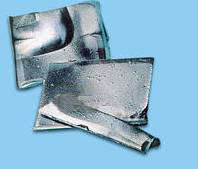Nickel
Nickel is found as a constituent in most meteorites and often serves as one of the criteria for distinguishing a meteorite from other minerals. Iron meteorites, or siderites, may contain iron alloyed with from 5 to nearly 20% nickel. Nickel is a silvery white metal that takes on a high polish. Nickel is hard, malleable, ductile, somewhat ferromagnetic, and a fair conductor of heat and electricity.
Nickel uses and production
Nickel is primarily sold for first use as refined metal (cathode, powder, briquet, etc.) or ferronickel. About 65% of the nickel consumed in the Western World is used to make austenitic stainless steel. Another 12% goes into super alloys (e.g., Inconel 600) or nonferrous alloys (e.g., cupronickel). Both families of alloys are widely used because of their corrosion resistance. The aerospace industry is a leading consumer of nickel-base super alloys. Turbine blades, discs and other critical parts of jet engines are fabricated from super alloys. Nickel-base super alloys are also used in land-based combustion turbines, such those found at electric power generation stations. The remaining 23% of consumption is divided between alloy steels, rechargeable batteries, catalysts and other chemicals, coinage, foundry products, and plating. The principal commercial chemicals are the nickel carbonate (NiCO3), nickel chloride (NiCl2), nickel oxide (NiO), and nickel sulfate (NiSO4). In aqueous solution, the divalent nickel ion has an emerald-green color.
Nickel salt
Nickel Salt is a silvery-white metal salt that takes a high polish. Nickel Salt belongs to the transition metals and is hard and ductile. Nickel salt occurs most usually in combination with sulfur and iron in pentlandite, with sulfur in millerite, with arsenic in the mineral nickeline, and with arsenic and sulfur in nickel glance. Our range of nickel salt includes nickel sulphate, nickel sulfate heptanhydrate,nickel acetate, nickel carbonate and so on.
